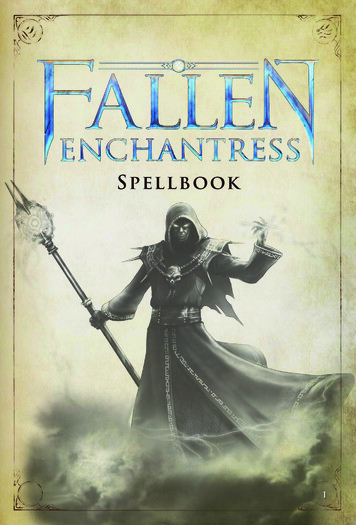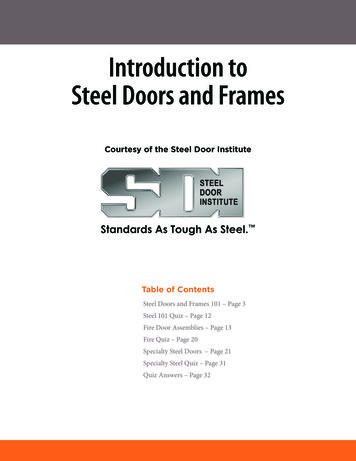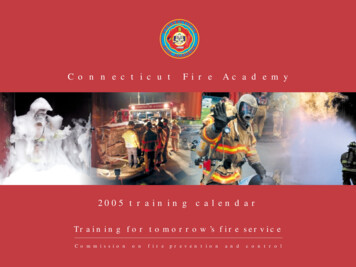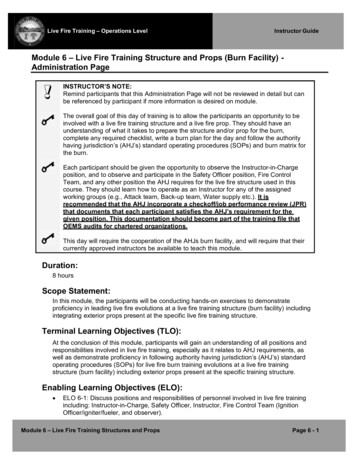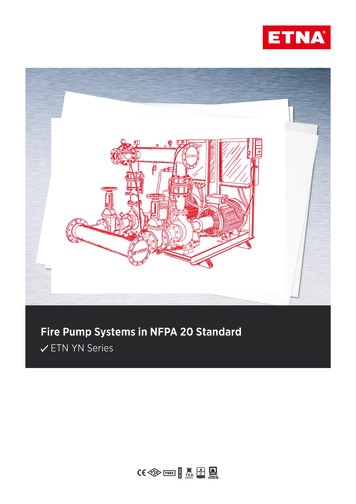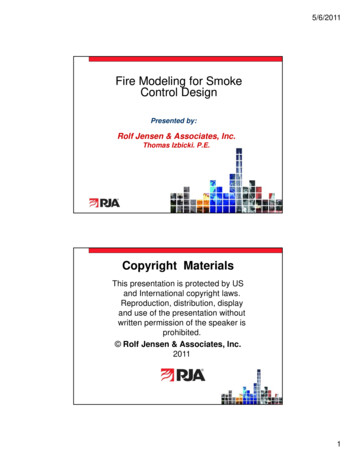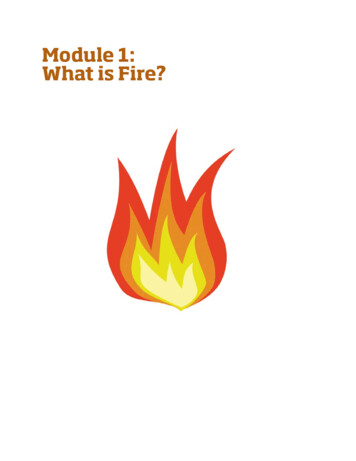
Transcription
Module 1:What is Fire?
Module 1: What is Fire?Proposed AgendaTimeSection name9:009:30Welcome and group introductions9:3010:00Course overview10:0010:40Wildland fire history10:4011:00Break11:0011:40The influence of fire on cultural mythology, with activity11:4012:15Basic chemistry12:151:15Lunch1:152:00Fire triangle with activity2:002:30Break2:303:10Fire intensity and fire severity3:103:30Future module plans, wrap-upOverview Know the components of the fire triangle Know the difference between fire intensityand fire severityThis module provides a brief overview ofwildland fire history and the influence that firehas had on cultural mythology around the world.Module 1 also addresses the general principlesof fire that are applicable to both wildland andstructural fire. These principles include elementsrequired for a fire to burn, and some definitionspertaining to fire effects. Understanding theseprinciples is essential to understanding fire.Learning OutcomesDemonstrate knowledge of fire including thecomponents necessary for fire, combustion, andways to put a fire out.Content Outline Wildland fire history Fire’s influence on cultural mythologyaround the world Basic chemistry Fire triangle Fire behavior triangle Fire intensity and severityLearning Objectives Understand wildland fire history Understand the influence that fire has hadon cultural mythology around the world Know that fire is part of a chemical reactioncalled combustion2
Module 1: What is Fire?“The agent by which fire was first brought down to earth and made available to mortal man waslightning. To this source every hearth owes its flames”LucretiusDe Rerum Natura, 50 BCor iron onto suitable tinder, was a commonlyused primitive technique for making fire. Firewas used as a tool to clear ground for humanhabitats, to facilitate travel, to kill vermin, tohunt, to regenerate plant food sources (for bothhumans and livestock), to use for signaling, andeven to use in warfare among tribes.Wildland Fire HistoryThe origin of fire is tied to the origin ofplants. Plants are responsible for two of the threeelements essential to the existence of fire: oxygenand fuel. The third element, a heat source, hasbeen available throughout the history of Earth—mainly through lightning (Pausas and Keeley2009).Much is written about the dense, primevalforests of North America—from coast to coast.Equally impressive to early European settlerswere the great open expanses of prairies,meadows, and savannas, most of which werecreated and maintained by native burning(Figure 1).Plants and trees smoldering from a lightningstrike or any source of hot coals may have beenthe first resources exploited by humans to controlfire. Friction using the flint-and-steel method,where hot sparks are struck from a piece of steelImage: Frederic RemingtonFigure 1. “The Grass Fire” by Frederic Remington depicted Native Americans setting a grass fire. The picture was painted in1908 and is owned by Amon Carter Museum in Fort Worth, Texas.3
Module 1: What is Fire?competing tribes or to use the smoke to cover upan escape. They also used fire to burn potentialenemy hiding places and to signal war activityto nearby groups (Tveskov et al. 2002, Pullen1996, LaLande and Pullen 1999).A story on native burning was written bySharon Levy (2005), a freelance writer in Arcata,California. Levy wrote about Amelia Lyon, whowas a member of the Hupa Tribe of northernCalifornia. Amelia practiced what generationsof women in her culture did—maintaining theopen oak woodlands near what is now RedwoodNational Park. Amelia tended the open oakstands by burning the undergrowth every yearand thereby encouraging health and vigor in thestanding trees, and more importantly, generousacorn crops. Since her death in the late 1800s, thenative tradition of burning ended.For the Takelma, fire was an essential tool formaintaining healthy food sources year after year.As a result of the tarweed seed, grasshopper,and deer-drive burns, overgrowth of brush andsmall trees was kept to a minimum, maintaininga larger open, oak savanna. The Takelmanuse of anthropogenic fire provided them withsustainable food resources, but also maintaineda healthy habitat for large game animals,encouraged biological diversity, minimized fuels,and decreased the probability of catastrophicwildfires (LaLande 2004).1Other historical accounts suggest that theTakelma women (from the Rogue Valley ofinterior southwest Oregon) were responsiblefor the majority of the seasonal burns used forharvesting foods (Tveskov et al. 2002). Theyused fire to roast and collect sunflower andtarweed seeds, grasshoppers, and yellow jacketlarvae, and to make it easier to locate acornsfor collection while also suppressing boringinsects. These regular fires in the oak or grasssavanna also encouraged the growth of healthierbasketry materials; the same was done athigher elevations to encourage the new growthof beargrass, the leaves of which are anotherimportant basket-weaving and regalia-makingmaterial. Activity I – Fire history2 Demonstrate how a fire is started usingflint and steel, bow and friction, and a fuelsource such as tinder.Legendary forest fires like the Peshtigo Fireof 1871 in Wisconsin and the Great Fire of 1910in Montana and Idaho bolstered the argumentthat forest fires threatened commercial timbersupplies and contributed to the philosophy thatfire was a danger that needed to be suppressed.Before the middle of the 20th century, mostforest managers believed that fires should besuppressed at all times. By 1935, the U.S. ForestService’s fire management policy stipulated thatall wildfires were to be suppressed by 10 a.m.the morning after they were first spotted.Complete fire suppression was the objective. In1968, policies started to shift and the NationalPark Service changed its policy to recognizeAn expansive, grassy oak savanna is theperfect foraging ground for game animals likedeer and elk. When the Takelma burned theoak savanna, keeping trees and brush out andgrass growth abundant, they also ensured thedeer and elk populations would stay in the area,providing an important meat source.When it was time to hunt the mammals,larger fires were used once again for deer drives,frightening the scattered deer into smallerareas and eventually trapping them in a brushenclosure where hunters waited.LaLande, J. and R. Pullen. 1999. Burning for a ‘Fine andBeautiful Open Country’: Native Uses of Fire in SouthwesternOregon. Indians, Fire, and the Land in the Pacific Northwest.Oregon State University Press, Corvallis, OR.1In some instances, the Takelma used fireduring warfare to scare away or hinder travel ofRefer to the Activities section for more details on allActivities in this curriculum.24
Module 1: What is Fire?Fire has had a very strong albeit differentimpact on forests throughout Oregon dependingon the fire regime of the ecoregion. Forests thathistorically burned frequently (every 4–25 years)but with low intensity include the WillametteValley oak and the drier conifer forests likeponderosa pine. High-severity wildfiresoccurred in the state’s wetter regions and higherelevations (i.e., coastal forests, lodgepole pineand subalpine forests). These fires were veryintense, killing most of the trees. Historically,they occurred infrequently—only every 100 to450 years—and often were very large. Someforest types had a history of both low- and highseverity fires. These forests typically burnedevery 40 to 80 years (i.e., dry/wet mixed coniferforests).fire as an ecological process. The Forest Servicefollowed suit in 1974 by changing its policyfrom fire control to fire management. Currentfire suppression efforts by land managers havefocused on protecting the public, the wildlandurban interface (WUI), and other valuableresources.Shifts and changes in policy and managementhave altered fire regimes over time. Historicallyhigh-frequency, low-severity fire regimes havebeen replaced with low-frequency, high-intensitycrown fires that are outside the natural range ofvariability.Natural range of variability uses history as thebenchmark for comparison between the range ofecological conditions prior to human alterationsand the desired range of future conditions.One study conducted by Zennaro et al.(2014) measured 2,000 years of boreal forest firehistory from Greenland. Fourteen major events(“megafires”) were recorded where fires of suchgreat magnitude burned that charcoal fromplumes carried to Greenland were deposited.How do we know what the historic fireregimes were? There are several methods tomeasure and assess fire and disturbance historythrough time. Ice core analysis is one methodthat has been conducted for the last 40 years bymeasuring gases and charcoal sediments trappedin the ice. Measurements can go back in timeover 100,000 years.The highest concentrations of charcoal inice cores from Greenland coincide with Vikingsettlements during the “Little Climatic Optimum”between 920 and 1110 Common Era (CE). Thelowest concentrations of charcoal in ice cores wasmeasured during the “Little Ice Age” between1400 and 1700 CE. Another rise was measuredduring 1910 when the Great Fire occurred inMontana and Idaho.The negative aspects are that ice coremeasurements are by necessity taken in remotesites and do not measure local vegetationvariability.Photo: Taxelson/CC BY-NC-SA 2.0Figure 2. Tree rings of a Norwegian spruce.5
Module 1: What is Fire?Photo: Chris Schnepf, University of IdahoFigure 3. Fire scars are visible on this crosscut section of Pinus ponderosa.Dendrochronology is another method ofmeasuring fire and disturbance history. It is theextraction of tree cores to measure growth ringsand fire scars (Figures 2 and 3). This methodis site specific and is good for mapping firehistory across a landscape. Also, this method canillustrate the level of fire intensity—assumingthe tree survived a wildland fire—and frequencyfor potentially hundreds of years. Disadvantagesare that the record is limited to certain species(trees prone to heart rot cannot be measured)and only measures back a few hundred years atmost (the lifespan of most tree species). Anotherdisadvantage is that high-intensity fires cannotbe measured due to mortality of trees, and verylow-intensity fires cannot be measured becausethey are not intense enough to leave a scar, andtherefore be recorded in growth rings.Sediment (including pollen, sediment, andcharcoal) cores have also been used to measuredisturbance history. Similar to tree cores, thesecores may not give a clear picture of low-intensityfires and are relatively site specific—primarilyto water-prone, micosites, extracted from lakes,fens, and/or bogs. The measurement is alsorestricted to certain species of tree, shrub, andgrass due to the nature of pollen decompositionof certain species. However, these cores can givea good vegetation succession history that cango far back in time—potentially over thousandsof years. For example, a measurement core wastaken in a western red-cedar/hemlock plantassociation in northwest Montana. Precipitationat the time (1995) was about 70 inches annually,which resulted in the warm and moist conditionssuitable for those species. The sediment coremeasured back 7,000 years and illustrated achanging climate and different vegetation—aswell as different fire frequencies and severities.On this particular landscape, 4,000 to 7,000 Activity II – Fire history Examine cores from trees and comparegrowth, climate, and disturbance history.6
Module 1: What is Fire?years previous, the climatewas cooler and drier withsubalpine fir being thedominant species. From 2,500to 4,000 years previous, theclimate was cooler and drierwith true fir (Abies) being thedominant species. The currentvegetation assemblages didnot appear dominant inthe record until 2,500 yearsfrom the present time ofmeasurement (Chatters andLeavell 1994).A correlation was madeto regional temperaturemeasurements, availablemoisture, regional floodingevents, and native populationrises and declines (Figure 4).Humans have hadprofound impacts on firehistory and consequentlyhave altered fire regimesacross the landscape. Theinteraction between fireand anthropogenic-inducedclimate change contributesCredit: D. Leavell (2000).to future uncertainty. ForFigure 4. Graphic illustrates the relationship between temperatures, availableexample, an increase inmoisture, Columbia River floods, and anthropogenic fire in the Kootenai Nationalthe frequency of extremeForest.droughts as a result of climatechange may facilitate the spread and intensityof fires. An increase in global temperaturemay also alter fuel continuity in very differentways in different ecosystems (Figure 5). Anunderstanding of the natural range of variability,both past and future, in which a forest willremain resilient, dynamic, and productiveis helpful for developing forest- and firemanagement activities for the future.Source: Goddard Institute for Space StudiesFigure 5. Graph illustrates how global land and oceantemperatures have been rising in recent decades.7
Module 1: What is Fire?Fire’s Influence on CulturalMythology Around the WorldFire can be a friendly, comforting thing, asource of heat and light, as anyone who hasever sat by a campfire in the dark knows. Yetfire can also be dangerous and deadly, racingand leaping like a living thing to consume allin its path. In the mythology of virtually everyculture, fire is a sacred substance that gives lifeor power.3Agni, the god of fire in Hindu mythology,represents the essential energy of life in theuniverse (Figure 6). He consumes things, butonly so that other things can live. Fiery horsespull Agni’s chariot, and he carries a flamingspear. Agni created the sun and the stars, andhis powers are great. He can make worshipersimmortal and purify the souls of the dead fromsin. One ancient myth about Agni says that heconsumed so many offerings from his worshipersthat he was tired. To regain his strength, he hadto burn an entire forest with all its inhabitants.Chinese mythology includes stories of HuiLu, a magician and fire god who kept 100firebirds in a gourd. By setting them loose, hecould start a fire across the whole country.There was also a hierarchy of gods in charge offire. At its head was Lo Hsüan, whose cloak,hair, and beard were red. Flames spurted fromhis horse’s nostrils. He was not unconquerable,however. Once, when he attacked a city withswords of fire, a princess appeared in the sky andquenched his flames with her cloak of mist anddew.Image: E.A. Rodriquez,/ CC BY-NC-SA 2.0Figure 6. Agni, the god of fire.a coyote steals fire for people. Sometimes awolf, woodpecker, or other animal steals thefire. According to the Navajo, a coyote trickedtwo monsters that guarded the flames on FireMountain. Then he lit a bundle of sticks tied tohis tail and ran down the mountain to deliverthe fire to his people.4In the Christian belief system, the Devilhimself appears in some fire-related folktales. Inparts of Europe, it is believed that if a fire won’tdraw properly, it’s because the Devil is lurkingnearby. In other areas, people are warned notto toss bread crusts into the fireplace because itwill attract the Devil (although there’s no clearA number of Native American culturesbelieve that long ago some evil being hid fireso that people could not benefit from it. Ahero had to recover it and make it available tohuman beings. In many versions of the story,3This material drawn from http://www.This section is excerpted from thencyclopedia.com/Dr-Fi/Fire.html8
Module 1: What is Fire?explanation of what the Devil might want withburnt bread crusts).5According to the National Park Service (NPS.gov), fires remove dead trees and litter from theforest floor. Shrubs and trees invading grasslandsalso are killed by fires. In each example, newhealthy regrowth occurs. Fire does not implydeath, but rather change. As fire was associatedwith rebirth and renewal in mythology, so fire isnow recognized as an instrument of change anda catalyst for promoting biological diversity andhealthy ecosystems.The manifestation of the divine in theform of fire may be found in the Abrahamicfaiths as well. In Christianity, for example, theHoly Spirit is said to have descended on theapostles in the form of tongues of fire on theday of Pentecost. The manifestation of Godin the element of fire is also found in the OldTestament, as evident from a passage in thebook of Exodus where God spoke to Mosesfrom the burning bush. Abrahamic faiths alsoacknowledge the destructive power of fire. Thedestructive dimension of this element is attimes associated with the wrath of God, and anumber of verses from the Bible have been usedto illustrate this. Another way of interpreting thedestructive power of fire is to view it as a meansof purification. In other words, fire could besymbolically seen as a way to ‘burn’ away one’sevil urges.6 Activity III – Fire’s influence oncultural mythology Have students read Personal andProfessional Insights. Have students bring in stories, poems, orother art pieces about fire. Then have studentswork in groups to share and discuss theirpieces.Exerpt from “Fire Folklore and Legends,” ges/boards/thread/2944606256Material drawn from 4404.)9
Module 1: What is Fire?“In simplest terms, fire exists because the Earth holds life. Life pumped the atmosphere with oxygen.Life lathered the land with hydrocarbons. The chemistry of combustion is among life’s most elementalreactions, for it simply takes apart what photosynthesis puts together.”Stephen J. PyneTending FireBasic Fire ChemistryFire is a chemical reaction in which energyin the form of heat is produced. The chemicalreaction is known as combustion. Combustionoccurs when fuel or other material reacts rapidlywith oxygen, giving off light, heat, and flame. Aflame is produced during the ignition point in thecombustion reaction and is the visible, gaseouspart of a fire. Flames consist primarily of carbondioxide, water vapor, oxygen, and nitrogen.Image: Education Development Center/CC BY-NC-SS 4.0Figure 7. Diagram depicting photosynthesis.ignition source (Figure 8). Without one of thesecomponents, fire cannot exist. For a fire to ignite,there must be an initial and continued heatsource—this is called a chain reaction and is partof what makes up the fire tetrahedron.Combustion is the opposite process ofphotosynthesis. Combustion is the breakingapart of the building blocks put together throughphotosynthesis. Combustion is the release of theenergy acquired during photosynthesis. Oxygenis introduced, and bonds in the fuel of hydrogenand carbon are broken (releasing energy), theresulting hydrogen and carbon combiningseparately with the oxygen as H2O and CO2,releasing heat in the process. Photosynthesis isthe process of plants slowly absorbing the energy(heat) from the sun and building/growing tissue(Figure 7). Carbon dioxide is stored in the tissue,and oxygen is given off into the atmosphere.Combustion is the process of that tissue (plantmatter) burning—oxygen is consumed, andcarbon dioxide and heat are released into theatmosphere.Heat allows fire to spread by removing themoisture from nearby fuel, warming surroundingair, and preheating the fuel in its path. When thefire becomes either fuel-controlled (i.e., there isno more fuel to burn) or ventilation-controlled(i.e., there is not enough oxygen to sustaincombustion), the fire decays to a smoldering state.Four ways to put out a fire:1.2.3.4.Cool the burning material.Exclude oxygen.Remove the fuel.Break the chemical reaction.Heat/ignition sources include anythingcapable of generating heat—lightning, cigarettes,powerlines, catalytic converters, small enginesparks, matches, a magnifying glass.Fire TriangleThe fire triangle includes the three componentsthat must be present for a fire to burn. Thesecomponents are fuel, oxygen, and a heat/10
Module 1: What is Fire?and ignite with explosive force. A backdraft isan air-driven event, unlike a flashover, which istemperature driven. The fact that most fires areair regulated and not fuel regulated makes theunderstanding of backdrafts so important.A “flashover” in the wildland environmentis called a Generalized Blaze Flash (GBF)phenomenon. The GBF is defined as a rapidtransition from a surface fire exhibiting relativelylow intensity to a fire burning in the wholevegetation complex, from surface to canopy,and demonstrating dramatically larger flameheights, higher energy release rates, and fasterrates of spread. This can occur when the ambientair temperature rises dramatically, the relativehumidity drops significantly, and the wind speedrises. When all three conditions occur in thewildland, a GBF can develop from a slow-movingground fire to a raging crown fire. All fuel (forest,range, grassland) burns simultaneously. From allappearances, this looks, acts, and feels just like aflashover in a confined space structure—but overmany acres in a wildland setting.Source: Gustavb/CC BY-SA 3.0Figure 8. The Fire TriangleFuel sources include any kind of combustiblematerial—grass, shrubs, trees, houses, propanetanks, wood piles, and decks. Fuels arecharacterized by their moisture content (howwet the fuel is), size, shape, quantity, and thearrangement in which they are spread over thelandscape.The last part of the triangle is oxygen.Ambient air is made up of approximately 21percent oxygen and most fires require at least 16percent oxygen content to burn. A fire ignited inan area that has little oxygen will support only asmall flame. Activity IV – Fire Triangle This demonstration illustrates that if youtake one factor (oxygen, fuel, heat source) ofthe Fire Triangle away, the fire will go out.Fire Behavior TriangleIf oxygen is suddenly and rapidly addedto a nearly suffocated fire, the re-oxygenatedair will quickly ignite, creating large anddangerous flames known as a flashover orbackdraft. Flashover is a term used in structuralfirefighting and is by definition “the suddeninvolvement of a room or an area in flames fromfloor to ceiling caused by thermal radiationfeedback.” A flashover reaches high temperatures(over 1,000oF) so quickly that all flammablecontents spontaneously ignite and conditionsbecome untenable and unsafe.While the fire triangle describes thecomponents required to sustain a fire, the firebehavior triangle describes the components thatdetermine how a fire burns—topography, weather,and fuels. Fuels is the common denominatorbetween the two triangles. The fire behaviortriangle and its components will be covered inmore depth in Fire Behavior Module 3.Fire Intensity and FireSeverityA backdraft is a smoke explosion that occurswhen additional air is introduced to a smolderingfire and heated gases enter their flammable rangeFire intensity and fire severity will be definedin more detail in Module 3 but, for now, it helpsto understand that fire intensity and fire severity11
Module 1: What is Fire?Photo: Mike McMillan, U.S. Forest ServiceFigure 9. 2013 Rim Fire in and near Yosemite National Park in Californiaboth characterize a fire but describe entirelydifferent concepts. Fire intensity is the amountof heat (energy) given off by a forest or structurefire at a specific point in time (Figure 9).Fire severity is a product of fire intensityand residence time, and refers to the effects ofa fire on the environment, typically focusing onthe loss of vegetation both aboveground andbelowground but also including soil impacts(Figure 10).While a fast-moving, wind-driven fire maybe intense (lots of heat), a long-lasting fire thatjust creeps along in the forest underbrush couldtransfer more total heat to plant tissue or soilin a given area. In this way, a slow-moving,low-intensity fire could have more severe andcomplex effects on something like forest soil thana faster-moving, higher-intensity fire in the samevegetation. (Hartford and Frandsen 1991).Photo: Northern Research Station, U.S. Forest ServiceFigure 10. High-severity fires can cause intense damage toboth the overstory and understory.Fire conditions can also vary considerablythroughout a structure. One area of the buildingcould be in a fully developed stage while adifferent area might be in the growth or decay12
Module 1: What is Fire?Photo: Sylvain PedneaultSource: Battalion Chief Ed Hartin, www.firehouse.comFigure 11. A major fire engulfs an urban structure despiteefforts by firefighters to extinguish it.Figure 12. Fire development and fire behavior indicators.stages of the fire. Like in wildland fire, theintensity and severity of these fires at each stagewill depend on available heat, fuel, and oxygen(Figure 11).Notes to InstructorRoom SetupThe facilitator should secure a roomlarge enough to comfortably accommodateparticipants. Organize the room in a U‐shapefashion with long tables and chairs. The roomshould have a large screen to display thepresentation. There should be a large table upfront (6 to 8 feet in length) for the instructor touse for in‐class demonstrations and to displayvarious props. The room should be equipped witha fire extinguisher, water faucets (or access to awater supply), and be suited for demonstrationsthat require the use of fire.Fire developmental stages include (Figure 12): Incipient stage Growth stage Flashover stage Fully developed stage Decay stageDevelopment of the incipient fire is dependenton the characteristics and configuration ofthe fuel involved. If there is adequate oxygen,additional fuel will become involved and theheat release rate from the fire will increase; this isconsidered the growth stage. The flashover pointis the sudden transition from a growth stage tofully developed fire. When flashover occurs, thereis a rapid transition to a state of total surfaceinvolvement of all combustible material withinthe compartment. In the post-flashover stage,energy released is at its greatest but is limited byventilation. When the available fuel is consumedor there is limited oxygen, the fire is thenconsidered in decay stage (Hartin 2008).Total Time NeededApproximately 6 hours in the classroomEquipment/Materials Needed Computer with PowerPoint Projector and screen Handouts Flipcharts and easels or wall space Tree cores Flint, steel, and tinder bundle Candle, glass jar, petroleum jelly, andlighter13
Module 1: What is Fire?Delivery Methodsinstructor should then evaluate and weigh in onthe discussion. Presentation from instructors In‐class demonstrations Outdoor demonstration Discussion Online with CanvasClass evaluation—Provide a survey for studentfeedback for each module as a form of formativeevaluation.ActivitiesHandoutsI. Fire Starting NWFSC, 2015 – What is? Fire Intensity NWFSC, 2015 – What is? Fire Severity A copy of the PowerPoint presentation (3slides per page to allow for note taking) Other handouts can be downloaded fromthe section, “Additional Student Resources.” Demonstrate how a fire is started usingflint and steel, bow and friction, anda fuel source such as tinder (outsidedemonstration)II. Tree ExaminationsPowerPoints/Videos Examine cores from trees and comparegrowth, climate, and disturbance history(in-class demonstration) Module 1 – What is Fire?—PowerPoint Why Fire is Good (But you still shouldn’tstart a forest fire)—video https://www.youtube.com/watch?v 14USIqGFSW4&feature youtu.beIII. Mythology Fire’s influence on cultural mythology (inclass discussion) Have students bring in stories, poems,or other art pieces about fire. Then havestudents work in groups to share anddiscuss their pieces.Evaluation InstrumentStudent evaluation—Have a set of questionsthat touch on the different topics covered inthe module. Ask people to provide thoughtsand discussion on one or two questions. The14
Module 1: What is Fire?He scored high enough on the entrancescores to get into a communication/intelschool back East. Before he left, he waspermitted to attend the military’s fireacademy. The emphasis was on shipboardfirefighting, but all the basics were covered.The live-fire exercises in the huge concretebunker were the best, even though so manyothers were frightened of the black, oily smokeand intense heat. He didn’t have the sense tobe fearful—only encouraged to be closer to theflames.III. (con’t) Personal and ProfessionalInsightsFire, fire, fire. Not that it meansanything, but he was born in March—on adate that is supposed to be influenced by thefire sign. Adults told him later that whenaround 2 to 3 years old he played alone in theutility room where his cot lay.He found a screwdriver and tried totake apart the bare-wire socket hanging onthe wall. When the adults rushed in throughthe smoke, the wall had caught on fire and hestood there laughing at the flames.The shipboard fires on the high seas didnot deter his desire to be close to the flames.After leaving the service, he enrolled in acollege, courtesy of the GI Bill, and workedtowards a bachelor’s degree in Forestry—because it was a ticket to working in thewoods away from cities and people.Growing up poor, he had no storebought toys, but delighted by the hour inbuilding model homes, trees, cars, and peopleout of scraps of cardboard. When the citywas finished, he would burn it all down withmatches stolen from the kitchen—or with themagnifying glass—or the butt-end of illicitcigars. As a teenager, running with gangswasn’t enough, and he proved his delinquencyby stuffing 15-foot-diameter storm drainswith dried shrubs and tumbleweeds. Once thedrains were full, he would ignite them withstolen matches he always seemed to have. The100-foot flames that shot out of the stormdrain attracted the police—and the juveniledelinquency court.His first part-time job with the ForestService was as a grunt technician at the FireControl L
on cultural mythology around the world Know that fire is part of a chemical reaction called combustion Know the components of the fire triangle Know the difference between fire intensity and fire severity Learning Outcomes Demonstrate knowledge of fire including the components necessary for fire, combustion, and ways to put a fire out.

